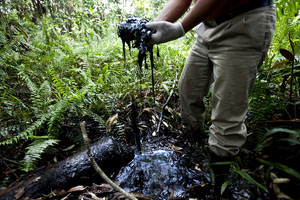
Oil is a dirty business. There’s just no way around it. Drilling for oil, transporting it across the globe, refining it into fuel – every step of the process is as dirty and destructive as can be. And that’s even when things go right.
Of course, as we’ve all witnessed far too often, things don’t always go right, and oil spills are as inevitable as the rest of the pollution caused by the oil business.
In just the past week, for instance, a Chevron pipeline spilled about 500 barrels in Salt Lake City, Utah; Chevron’s Richmond, CA refinery spilled 1,300 barrels; and it was revealed that Chevron’s North Burnaby refinery in British Columbia, Canada is still leaking oil into the Burrard Inlet seven months after it was first discovered.
(It’s not just oil, either. Chevron’s Pascagoula, Mississippi refinery reported a release of Benzene, a known carcinogen, earlier this week.)
What has also become abundantly obvious is that Chevron just seems to regard oil spills as a normal course of doing business. The company’s chief concern when a spill occurs is to minimize the impact to its bottom line, not to people or the environment — just as we’ve seen in Ecuador, where the company refuses to take responsibility for its 18 billion gallons of toxic oil waste in the Ecuadorean Amazon.
There are many more cases to illustrate this point. The pipeline spill in Salt Lake City was the second in the past six months, for example. The first spill occurred back in June and resulted in some 33,000 gallons of crude oil being dumped into Red Butte Creek. Thankfully, this second spill has prompted federal regulators to finally step in and do what Chevron should have done back in June: shut down the 60-year-old pipeline, which travels through sensitive watersheds, until a thorough investigation has been done and the integrity of the pipeline is assured.
When Chevron does pretend to take environmental safety seriously, you can feel the insincerity radiating from every official statement. A recent forecast by Chevron showed that a spill off the coast of the Shetland Islands, where it is operating a deepwater well, could reach the coasts of England, Norway, and Greenland within two weeks of the spill. That’s as far ahead as the company could project the impacts of a spill, however, because the computer spill modeling software the company uses constantly crashes when set to make projections further out. But hey, what can they do? According to Chevron, this is the same software the whole industry uses. Feel safer?
This is why the trial to hold Chevron accountable for its oil pollution in Ecuador is not just about Ecuador. It’s not even just about Chevron. For far too long, Big Oil, Big Coal, and other extractive industries have been poisoning our planet and making a killing in the process. Ecuador needs to be the line in the sand. Companies like Chevron cannot continue to poison our planet with impunity — they must be held accountable for every bit of environmental destruction, every human rights violation, every impacted community.